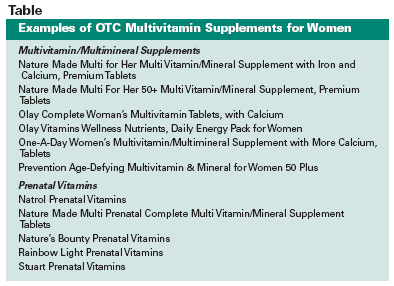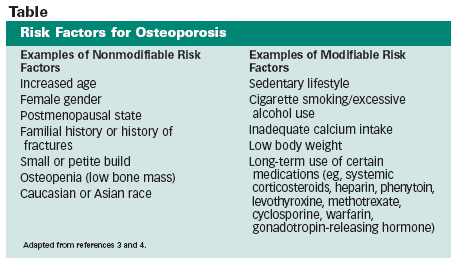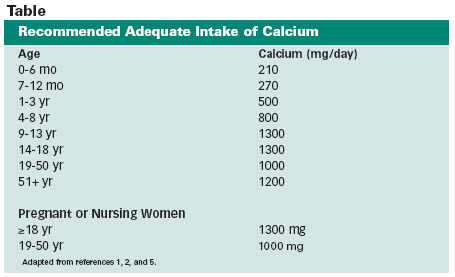Publication
Article
Pharmacy Times
Multivitamin Supplements for Women
Author(s):
It is estimated that more than half of adults in the United States take some type of dietary supplement. The majority of these supplements are multivita-min/multimineral supplements.1 As more women become proactive about improving their overall health by establishing a good nutritional plan and a routine exercise regimen, many also may consider the use of a daily multivitamin supplement to ensure that all of their nutritional needs are met.
Various multivitamin supplements currently on the market are formulated to meet the specific nutritional needs of women (Table 1). In general, these supplements contain several nutrients that promote overall health:
- Calcium, magnesium, and vitamin D to enhance and support bone health
- Folic acid
- Vitamins B6, B12, magnesium, and zinc for support of reproductive health
- Vitamins A, C, and E for extra anti-oxidant protection
Nutrients such as folic acid, vitamin B6, vitamin B12, magnesium, adn zinc also have been shown to be beneficial in women when experiencing premenstru-al syndrome, when using oral contraceptives, and during menopause.2 In addition, iron typically is found in the vitamin formulations for women, because iron supplementation often is warranted due to blood loss from menstruation.
The results of a recent study published in the October 2006 issue of the Journal of Clinical Pathology showed that vitamin D may slow the progression of breast cancer. British researchers found that women with early-stage breast cancer had much higher levels of vitamin D in their blood than women with more advanced breast cancer.3,4
Supplements for Special Groups of Women
Other multivitamin supplements for women include prenatal supplements that are formulated to meet the nutritional needs of a woman during preconception, pregnancy, and lactation. These supplements contain key nutrients that are crucial for a woman as well as for fetal development. For example, folic acid decreases the incidence of neural tube defects in infants. Most OTC prena-tal vitamins have as much as 800 mcg of folic acid.
As women age, their nutritional needs change. Therefore, they may want to consider using multivitamin supplements specifically targeted for individuals >50. These supplements may include increased levels of calcium, folic acid, vitamin D, vitamin E, vitamin B6, and other nutrients?but no iron, because individuals =50 require less iron and generally meet their iron needs through their diet alone.
Knowledge about medications and how they can affect the way the body uses nutrients is important. For example, medications can do the following:
- Decrease nutrient absorption
- Slow nutrient production
- Interfere with the body?s ability to metabolize nutrients
- Increase the loss of certain nutrients
Certain drugs affect mineral metabolism. For example, oral contraceptives can lower plasma zinc levels and increase copper levels. Certain drugs also affect vitamin absorption or metabolism, as is the case with anticonvulsants, which can cause vitamin D deficiency.5
Patient Counseling
Pharmacists can be a fundamental source of information for women interested in selecting multivitamin supplements in various stages of life.
Because there are potential interactions between many drugs and vitamins and minerals, pharmacists are key in identifying individuals at risk for interactions and making clinical recommendations accordingly.
Prior to recommending any multivita-min supplements, pharmacists should assess the patient?s allergy history, medical history, and complete medication profile (including homeopathic medications) to determine any drug/ micronu-trient or micronutrient/micronutrient interactions or possible contraindica-tions for use.
Patients with preexisting medical conditions and pregnant or lactating women always should be advised to consult with their primary physician to ensure the appropriateness of these supplements.
It also is important for pharmacists to remind patients to use these products as directed and only at the recommended daily dosage.
Pharmacists should stress the importance of adhering to a balanced diet and incorporating various lifestyle modifications, such as not smoking, eliminating or limiting alcohol use, and establishing a routine exercise regimen.



References
1. National Institutes of Health State-of-the-Science Conference on Multivitamin/Mineral Supplements and Chronic Disease Prevention. National Institutes of Health Consensus Development Program Web site. Available at: http://consensus.nih.gov/2006/2006MultivitaminMineralSOS028main.htm.
2. Bayer Healthcare LLC. One A Day Vitamin Web site. Available at: www.oneaday.com.
3. Warner J. Vitamin D May Affect Breast Health. Medscape Web site. Available at: www.medscape.com/viewarticle/546787.
4. Palmieri C, MacGregor T, Girgis S, Vigushin D. Serum 25-hydroxyvitamin D levels in early and advanced breast cancer. J Clin Pathol. 2006;59:1334-1336.
5. Nutrient?Drug Interactions. Merck Manuals Online Medical Library Web site. Available at: www.merck.com/mmpe/sec01/ch001/ch001d.html.







